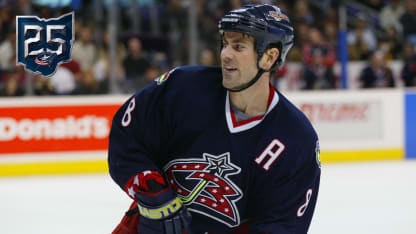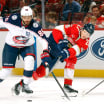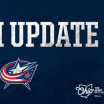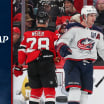Twenty-five years ago today, the Blue Jackets finally had their team.
The bulk of what would become a squad that enthralled sellout crowd upon sellout crowd at Nationwide Arena was set June 23, 2000, when the Blue Jackets went through the expansion draft.
The list of 26 players who became Blue Jackets that day in Calgary ranges from memorable to anonymous. It included the first captain in team history, the squad’s first goal scorer and the skater who would net the franchise’s first hat trick. Notable NHL names were interspersed with players who never skated a game in the league. There was someone named Dallas (Drake) and two players acquired from Dallas.
Though most didn’t last long in Columbus, many of the names would become part of the hockey history in the city, especially as the inaugural team ignited a love affair for the sport in the capital city.
In all, 12 of the 26 players chosen played for the 2000-01 Blue Jackets, including the top three goal scorers and five of the seven leaders in games played. Names like Geoff Sanderson, Tyler Wright, Kevin Dineen and Lyle Odelein are key parts of the CBJ story, and it all started on this date.
“I looked at the names last night because I hadn’t looked at it in 15 years probably,” Doug MacLean, then the general manager of the Blue Jackets, recently told BlueJackets.com. “A number of them were free agents that we knew we had no chance of signing or were going to come with us, and also a bunch of guys we didn’t want.
“And then there were a bunch of guys that actually we were pretty excited to get in the draft. We came out of it feeling, ‘OK, we had a pretty good day,’ considering what we were up against.”
A Different World
After the Blue Jackets and Minnesota Wild entered the league together in 2000, there were no expansion franchises until Vegas (2017) and Seattle (2021) joined almost two decades later. Both had degrees of immediate success, with Vegas reaching the Stanley Cup Final in its inaugural season and Seattle winning a playoff series in year two.
But back in the 1990s, as the league grew from 21 franchises at the start of the decade to 30 in the year 2000, teams were generally not set up for success. In 1991, San Jose became the first franchise to join the league since it absorbed four WHL teams in 1979, and the Sharks won just 17 games their first season.
Ottawa fared even worse in 1992-93 when the Senators won 10 games, and the team to immediately precede Columbus and Minnesota into the NHL, Atlanta, won 14 games its first campaign.
Things were further complicated by the fact that Nashville (1998) and Atlanta (1999) had just entered the league, making the Blue Jackets and Wild the third and fourth teams to join fray in a three-year span.
“It’s pretty bizarre when you think about it because obviously Nashville and Atlanta come in before us two separate years, and then we come in with Minnesota, which really changed the whole dynamic because things had been picked pretty clean by two previous expansions in back-to-back years,” MacLean told BlueJackets.com.
Even before you add in the fact that two teams were picking players instead of just one, the talent pool among the 316 players available wasn’t deep to begin with.
MacLean and his scouting staff – including assistant general manager Jim Clark and director of hockey operations Chris MacFarland – fanned out across the world in the year before the draft, helped by pro scouts Bob Strumm and Peter Dineen.
There were notable names who ended up available – Hall of Famers Mark Messier and Paul Coffey topped the list – but given their age (39 years old) and contracts, they weren’t going to end up in Columbus. Goalies Grant Fuhr and Bill Ranford had won four Stanley Cups and a Conn Smythe Trophy between them, but there was the complicating factor that they had announced their retirements.
Nashville and Atlanta were exempt from having players in the draft, while the other franchises in the league were able to protect either one goaltender, five defensemen and nine forwards, or two goaltenders, three defensemen and seven forwards.
(Contrast that to the two most recent expansions drafts, when teams could protect one goalie, three defensemen and seven forwards, or eight skaters and a goalie.)
“Oh, the scope of what's available ... all-time greats and all-time knuckleheads, multimillionaires and multiple offenders, old codgers and Jeff Odgers,” Columbus Dispatch writer Michael Arace penned at the time.
With two teams trying to stock rosters at once and only so many players available, MacLean and his counterpart in Minnesota, Doug Risebrough, had to get creative.
How It Happened
While the expansion draft didn’t happen until the day before the NHL entry draft in late June, the Blue Jackets had already started to put together a roster. The team signed its first free agent, Niagara University goalie Greg Gardner, on May 4, then inked wings Mathieu Darche and Jonathan Schill four days later. MacLean made his first trade May 11, adding center Chris Nielsen from the Islanders for a pair of draft picks.
Things intensified in the leadup to the expansion draft, with MacLean making deals with multiple teams. Among those, the Blue Jackets added winger Jan Caloun – who had just led Sweden’s domestic league in scoring – as well as a draft pick from San Jose on June 12 for the promise not to select goalie Evgeni Nabokov. At the expansion draft, a similar deal with Buffalo netted Jean-Luc Grand-Pierre and the ability to select Sanderson so the Blue Jackets wouldn’t take netminders Dominik Hasek or Martin Biron.
It was, in many ways, a whirlwind process.
"I took the last call at 2:20 a.m.," MacLean told The Dispatch back in 2000. "It was as intense a period as I've experienced in hockey. We were dealing with 28 teams, and we were sometimes working with and against (the Wild). It was a major, major challenge. When we started the actual drafting, I probably talked to 15 GMs in that period of time."
Before things kicked off, though, a crucial piece of luck went against the Blue Jackets. MacLean and Risebrough met with the league to determine two things – who would get the first pick in the expansion draft, and who would receive the third overall pick ahead of the other in the NHL draft.
It was done via a coin flip, with Minnesota winning to receive the third pick in the entry draft. The Wild would go on to draft forward Marian Gaborik, while Columbus took defenseman Rostislav Klesla.
Of course, having the third overall pick in that draft was a much more attractive option, especially for MacLean because the format of the expansion draft required the teams to select goaltenders first. The issue for Columbus? Having already acquired goalie Marc Denis in an early June trade with Colorado – and with the planned signing of free agent Ron Tugnutt – he had no use for them.
That is how Colorado goalie Rick Tabaracci became the answer to the trivia question as to who went No. 1 in the expansion draft, chosen as part of the deal with the Avs that netted Denis. MacLean would also go on to take goalies Frederic Chabot from Montreal and Dwayne Roloson from Buffalo with no intention of signing either.
“I already had Tugnutt and Marc Denis deals done before the expansion draft, so I had to take a whole bunch of goalies that I wasn’t planning on signing,” MacLean told BlueJackets.com. “And you had to pick them first! (People were like), ‘Why would he take Tabaracci? Why would he take whoever?’ I had the Tugnutt and Denis deals done, that's why I did it. I had to fill those spots.”
After each team had taken three goalies, the draft moved on to the defensemen, where the Blue Jackets strategy started to become clear. They added such pieces as future captain Odelein (Phoenix), Jamie Pushor (Dallas) and Mattias Timander (Boston); the three wound up being the top three CBJ defensemen in games played in the inaugural season.
They took flyers on a handful of European players (Tommi Rajamaki from Toronto and Jonas Junkka from Pittsburgh) they thought might contribute at some point without having to make a major commitment, and they selected Mathieu Schneider.
A veteran blueliner who had played in 80 games with the New York Rangers the year before, Schneider wasn't particularly of interest to the Blue Jackets, and the feeling was mutual as he was about to hit free agency.
“We took it really seriously, but halfway through the draft, Bill Daly called Riser and myself and said, ‘Hey, we got a problem going on here. You guys are picking all these free agents,’” MacLean remembers. “Well, that was the gist of the whole draft because you didn’t want to be stuck with players. We picked Mathieu Schneider, and we knew there was no chance in the world Mathieu Schneider was signing with us. But it got rid of one pick from a team.”
Up front, there Blue Jackets continued taking shots on some lottery tickets from Europe, taking Russians Dmitri Subbotin (New York Rangers) and Sergei Luchinkin (Dallas) as well as Czech forward Martin Streit (Pittsburgh), but the identity of the squad was built through some veterans with hard work and snarl as trademarks of their game.
A two-time 40-goal scorer early in his career, Sanderson was coming off of two tough seasons in Buffalo but was added to bring skill with the team’s first pick at forward. Columbus selected a pair of players with two 20-goal seasons in their past, Steve Heinze (Boston) and Robert Kron (Carolina), and brought in a pair of physical forwards with some scoring touch in Wright (Pittsburgh) and 37-year-old Kevin Dineen (Ottawa), Peter's brother.
Former Miami University forward Kevyn Adams was chosen from Toronto to return to the Buckeye State, while Tampa Bay forward Bruce Gardiner was chosen after bouncing around the league for a few years.
Becoming Blue Jackets
In Columbus, the question was immediately asked – how did the Blue Jackets do?
Dispatch columnist Bob Hunter’s one word analysis: “Fine.”
“Expansion drafts are often about seeing what you want to see,” Hunter wrote. “Most players have some kind of upside, even if their downside seems to outweigh it. The Blue Jackets picked up some serviceable guys, some guys who have been good and some guys who can be, so about all you can do now is sit back and wait.”
The Blue Jackets themselves were happy at the time with the roster they were able to assemble.
"I think if you asked anyone on our staff, we were thrilled with the defense that we were able to assemble," assistant GM Jim Clark told The Dispatch at the draft. "A couple of guys got pulled out of the draft because of deals ... but what we've ended up with are a half- dozen defensemen that we know can play in the league. They're all 6-foot-2, 200 pounds plus, so we have a big, strong defense that is going to make forwards pay the price when they come into our end of the building.
"We're happy about that. We've still got to find a little quickness back there. Maybe we can do that through free agency or through some other deals Doug is attempting to do. And when you look at us up front, you look at Geoff Sanderson, Robert Kron and Steve Heinze. They're all good veterans. They've all proven to be guys who can score in the NHL.”
Indeed, the fingerprints of the expansion draft were all over the Blue Jackets in the first season. Sanderson immediately became the team's top offensive threat, scoring 30 goals in his first season in Columbus and notching the franchise’s first hat trick Feb. 10 of the inaugural season vs. Nashville in Nationwide Arena. Heinze wasn’t far behind, netting 22 goals before going to Buffalo at the trade deadline for a draft pick.
Stanley Cup-winning defenseman Odelein was a free agent-to-be when he was chosen by the Blue Jackets and elected to sign, serving as the initial team captain and playing in 81 games the first season. Wright became a fan favorite for his on-ice play, including 16 goals in 2000-01, and his work in the community. Pushor had three stints with the Blue Jackets, playing in 75 games the first year, while Timander skated in 76.
The Kevins/Kevyns – Dineen and Adams, respectively – were physical, hard-working forwards that first season, while Gardiner’s biggest claim to fame was scoring the first-ever goal in franchise history on opening night vs. Chicago. Kron skated two seasons with the team to cap a 12-year career.
And while the original Blue Jackets weren’t a playoff team, they did help make Columbus a hockey town. Sellout crowds filled Nationwide Arena every night during the opening campaign, and the Blue Jackets put up a fight most nights. The first team went 28-39-9-6 and was a tough out by the end, going 10-8-2-0 in its final 20 games.
With 71 points, Columbus tied Chicago at the bottom of the Central Division standings. Perhaps most important to the franchise was finishing three points ahead of the Wild.
“We ended up in our first year finishing ahead of Minnesota in the standings, which was like winning the Stanley Cup to Mr. McConnell,” MacLean told BlueJackets.com, referring to team founder John H. McConnell. “Honestly, it was like the greatest thing ever. He was so excited that we finished ahead of Minnesota.”
Things didn’t last long for many of the expansion draft picks, however. While they were the steadiest performers on the inaugural squad, just two players selected – Wright and Sanderson – and two others acquired in trades – Denis and Grand-Pierre – played more than 200 games with the team.
There’s no denying, though, that the Blue Jackets truly started to take shape 25 years ago on this date.



















